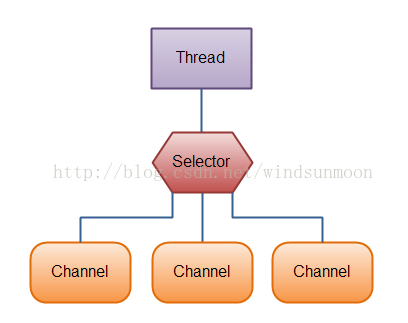Java之NIO(二)selector socketChannel
來源:程序員人生 發(fā)布時(shí)間:2015-06-19 08:25:49 閱讀次數(shù):6023次
上篇文章對(duì)NIO進(jìn)行了簡介,對(duì)Channel和Buffer接口的使用進(jìn)行了說明,并舉了1個(gè)簡單的例子來講明其使用方法。
本篇?jiǎng)t重點(diǎn)說明selector,Selector(選擇器)是Java NIO中能夠檢測(cè)1到多個(gè)NIO通道,并能夠知曉通道是不是為諸如讀寫事件做好準(zhǔn)備的組件。這樣,1個(gè)單獨(dú)的線程可以管理多個(gè)channel,從而管理多個(gè)網(wǎng)絡(luò)連接。
與selector聯(lián)系緊密的是ServerSocketChannel和SocketChannel,他們的使用與上篇文章描寫的FileChannel的使用方法類似,然后與ServerSocket和Socket也有1些聯(lián)系。
本篇首先簡單的進(jìn)selector進(jìn)行說明,然后1個(gè)簡單的示例程序,來演示即時(shí)通訊。
Selector
使用傳統(tǒng)IO進(jìn)行網(wǎng)絡(luò)編程,以下圖所示:

每個(gè)到服務(wù)真?zhèn)€連接,都需要1個(gè)單獨(dú)的線程(或線程池)來處理其對(duì)應(yīng)的socket,當(dāng)連接數(shù)多的時(shí)候,對(duì)服務(wù)真?zhèn)€壓力極大。并使用socket的getInputStream。Read方法來不斷的輪訓(xùn)每一個(gè)socket,效力可想而知。
而selector則可以在同1個(gè)線程中監(jiān)聽多個(gè)channel的狀態(tài),當(dāng)某個(gè)channel有selector感興趣的事情發(fā)現(xiàn),selector則被激活。即不會(huì)主動(dòng)去輪詢。以下圖所示:

Selector使用以下示意:
public static void main(String[] args) throws IOException {
Selector selector = Selector.open();//聲明selector
ServerSocketChannel sc = ServerSocketChannel.open();
sc.configureBlocking(false);//必須設(shè)置為異步
sc.socket().bind(new InetSocketAddress(8081));//綁定端口
//把channel 注冊(cè)到 selector上
sc.register(selector, SelectionKey.OP_ACCEPT|SelectionKey.OP_CONNECT|SelectionKey.OP_READ|SelectionKey.OP_WRITE);
while(true){
selector.select();//阻塞,直到注冊(cè)的channel上某個(gè)感興趣的事情產(chǎn)生
Set<SelectionKey> selectedKeys = selector.selectedKeys();
Iterator<SelectionKey> keyIterator = selectedKeys.iterator();
while(keyIterator.hasNext()) {
SelectionKey key = keyIterator.next();
if(key.isAcceptable()) {
// a connection was accepted by a ServerSocketChannel.
} else if (key.isConnectable()) {
// a connection was established with a remote server.
} else if (key.isReadable()) {
// a channel is ready for reading
} else if (key.isWritable()) {
// a channel is ready for writing
}
keyIterator.remove();
}
}
}
極簡即時(shí)通訊
本例子是是1個(gè)極其簡單的例子,很多地方都不完善,但是例子可以很好的說明selector的使用方法。
本例子包括服務(wù)端和客戶端兩個(gè)部份,其中服務(wù)端采取兩個(gè)selector,用來建立連接和數(shù)據(jù)的讀寫。兩個(gè)selector在兩個(gè)線程中。
服務(wù)端
/**
* 簡單的即時(shí)通訊服務(wù)端,采取建立連接 selector和數(shù)據(jù) selector分離。很不完善
*
*/
public class ServerSocketChannelTest {
private static final int SERVER_PORT = 8081;
private ServerSocketChannel server;
private volatile Boolean isStop = false;
//負(fù)責(zé)建立連接的selector
private Selector conn_Sel;
//負(fù)責(zé)數(shù)據(jù)讀寫的selector
private Selector read_Sel;
// private ExecutorService sendService = Executors.newFixedThreadPool(3);
//鎖,用來在建立連接后,喚醒read_Sel時(shí)使用的同步
private Object lock = new Object();
//注冊(cè)的用戶
private Map<String, ClientInfo> clents = new HashMap<String, ClientInfo>();
/**
* 初始化,綁定端口
*/
public void init() throws IOException {
//創(chuàng)建ServerSocketChannel
server = ServerSocketChannel.open();
//綁定端口
server.socket().bind(new InetSocketAddress(SERVER_PORT));
server.configureBlocking(false);
//定義兩個(gè)selector
conn_Sel = Selector.open();
read_Sel = Selector.open();
//把channel注冊(cè)到selector上,第2個(gè)參數(shù)為興趣的事件
server.register(conn_Sel, SelectionKey.OP_ACCEPT);
}
// 負(fù)責(zé)建立連接。
private void beginListen() {
System.out.println("--------開始監(jiān)聽----------");
while (!isStop) {
try {
conn_Sel.select();
} catch (IOException e) {
e.printStackTrace();
continue;
}
Iterator<SelectionKey> it = conn_Sel.selectedKeys().iterator();
while (it.hasNext()) {
SelectionKey con = it.next();
it.remove();
if (con.isAcceptable()) {
try {
SocketChannel newConn = ((ServerSocketChannel) con
.channel()).accept();
handdleNewInConn(newConn);
} catch (IOException e) {
e.printStackTrace();
continue;
}
} else if (con.isReadable()) {//廢代碼,履行不到。
try {
handleData((SocketChannel) con.channel());
} catch (IOException e) {
e.printStackTrace();
}
}
}
}
}
/**
* 負(fù)責(zé)接收數(shù)據(jù)
*/
private void beginReceive(){
System.out.println("---------begin receiver data-------");
while (true) {
synchronized (lock) {
}
try {
read_Sel.select();
} catch (IOException e) {
e.printStackTrace();
continue;
}
Iterator<SelectionKey> it = read_Sel.selectedKeys().iterator();
while (it.hasNext()) {
SelectionKey con = it.next();
it.remove();
if (con.isReadable()) {
try {
handleData((SocketChannel) con.channel());
} catch (IOException e) {
e.printStackTrace();
}
}
}
}
}
private void handdleNewInConn(SocketChannel newConn) throws IOException {
newConn.configureBlocking(false);
//這里必須先喚醒read_Sel,然后加鎖,避免讀寫線程的中select方法再次鎖定。
synchronized (lock) {
read_Sel.wakeup();
newConn.register(read_Sel, SelectionKey.OP_READ);
}
//newConn.register(conn_Sel, SelectionKey.OP_READ);
}
private void handleData(final SocketChannel data) throws IOException {
ByteBuffer buffer = ByteBuffer.allocate(512);
try {
int size= data.read(buffer);
if (size==⑴) {
System.out.println("-------連接斷開-----");
//這里暫時(shí)不處理,這里可以移除已注冊(cè)的客戶端
}
} catch (IOException e) {
e.printStackTrace();
return;
}
buffer.flip();
byte[] msgByte = new byte[buffer.limit()];
buffer.get(msgByte);
Message msg = Message.getMsg(new String(msgByte));
//這里讀完數(shù)據(jù)其實(shí)已可以另開線程了下1步的處理,理想情況下,根據(jù)不同的消息類型,建立不同的隊(duì)列,把待發(fā)送的消息放進(jìn)隊(duì)列
//固然也能夠持久化。如果在數(shù)據(jù)沒有讀取前,另開線程的話,讀寫線程中 read_Sel.select(),會(huì)立刻返回。可以把
if (msg.getType().equals("0")) {// 注冊(cè)
ClientInfo info = new ClientInfo(msg.getFrom(), data);
clents.put(info.getClentID(), info);
System.out.println(msg.getFrom() + "注冊(cè)成功");
} else {// 轉(zhuǎn)發(fā)
System.out.println("收到"+msg.getFrom()+"發(fā)給"+msg.getTo()+"的消息");
ClientInfo to = clents.get(msg.getTo());
buffer.rewind();
if (to != null) {
SocketChannel sendChannel = to.getChannel();
try {
while (buffer.hasRemaining()) {
sendChannel.write(buffer);
}
} catch (Exception e) {
}
finally {
buffer.clear();
}
}
}
}
public static void main(String[] args) throws IOException {
final ServerSocketChannelTest a = new ServerSocketChannelTest();
a.init();
new Thread("receive..."){
public void run() {
a.beginReceive();
};
}.start();
a.beginListen();
}
}
客戶端
/**
* new 次對(duì)象,然后調(diào)用start方法,其中self 是自己id
*
* to 是接收人id
*
*/
public class Client {
/**
* 自己的ID
*/
private String self;
/**
* 接收人ID
*/
private String to;
//通道管理器
private Selector selector;
private ByteBuffer writeBuffer = ByteBuffer.allocate(512);
private SocketChannel channel;
private Object lock = new Object();
private volatile boolean isInit = false;
public Client(String self, String to) {
super();
this.self = self;
this.to = to;
}
/**
* 取得1個(gè)Socket通道,并對(duì)該通道做1些初始化的工作
* @param ip 連接的
服務(wù)器的ip
* @param port 連接的
服務(wù)器的端口號(hào)
* @throws IOException
*/
public void initClient(String ip,int port) throws IOException {
// 取得1個(gè)Socket通道
channel = SocketChannel.open();
// 設(shè)置通道為非阻塞
channel.configureBlocking(false);
// 取得1個(gè)通道管理器
this.selector = Selector.open();
// 客戶端連接
服務(wù)器,其實(shí)方法履行并沒有實(shí)現(xiàn)連接,需要在listen()方法中調(diào)
//用channel.finishConnect();才能完成連接
channel.connect(new InetSocketAddress(ip,port));
//將通道管理器和該通道綁定,并為該通道注冊(cè)SelectionKey.OP_CONNECT事件。
channel.register(selector, SelectionKey.OP_CONNECT);
}
/**
* 采取輪詢的方式監(jiān)聽selector上是不是有需要處理的事件,如果有,則進(jìn)行處理
* @throws IOException
*/
@SuppressWarnings("unchecked")
public void listen() throws IOException {
// 輪詢?cè)L問selector
while (true) {
synchronized (lock) {
}
selector.select();
// 取得selector當(dāng)選中的項(xiàng)的迭代器
Iterator<SelectionKey> ite = this.selector.selectedKeys().iterator();
while (ite.hasNext()) {
SelectionKey key = ite.next();
// 刪除已選的key,以防重復(fù)處理
ite.remove();
// 連接事件產(chǎn)生
if (key.isConnectable()) {
SocketChannel channel = (SocketChannel) key
.channel();
// 如果正在連接,則完成連接
if(channel.isConnectionPending()){
channel.finishConnect();
}
// 設(shè)置成非阻塞
channel.configureBlocking(false);
//在和服務(wù)端連接成功以后,為了可以接收到服務(wù)真?zhèn)€信息,需要給通道設(shè)置讀的權(quán)限。
channel.register(this.selector, SelectionKey.OP_READ);
isInit = true;
// 取得了可讀的事件
} else if (key.isReadable()) {
read(key);
}
}
}
}
/**
* 處理讀取服務(wù)端發(fā)來的信息的事件
* @param key
* @throws IOException
*/
public void read(SelectionKey key) throws IOException{
SocketChannel data = (SocketChannel) key.channel();
ByteBuffer buffer = ByteBuffer.allocate(512) ;
try {
data.read(buffer );
} catch (IOException e) {
e.printStackTrace();
data.close();
return;
}
buffer.flip();
byte[] msgByte = new byte[buffer.limit()];
buffer.get(msgByte);
Message msg = Message.getMsg(new String(msgByte));
System.out.println("---收到消息--"+msg+" 來自 "+msg.getFrom());
}
private void sendMsg(String content){
writeBuffer.put(content.getBytes());
writeBuffer.flip();
try {
while (writeBuffer.hasRemaining()) {
channel.write(writeBuffer);
}
} catch (IOException e) {
// TODO Auto-generated catch block
e.printStackTrace();
}
writeBuffer.clear();
}
/**
* 啟動(dòng)客戶端測(cè)試
* @throws IOException
*/
public void start() throws IOException {
initClient("localhost",8081);
new Thread("reading"){
public void run() {
try {
listen();
} catch (IOException e) {
e.printStackTrace();
}
};
}.start();
int time3 = 0;
while(!isInit&&time3<3){
try {
Thread.sleep(1000);
} catch (InterruptedException e) {
e.printStackTrace();
}
time3 ++;
}
System.out.println("--------開始注冊(cè)------");
Message re = new Message("", self, "");
sendMsg(re.toString());
try {
Thread.sleep(200);
} catch (InterruptedException e) {
e.printStackTrace();
}
System.out.println("-----注冊(cè)成功----");
String content ="";
System.out.println("---- 請(qǐng)輸入要發(fā)送的消息,按回車發(fā)送,輸入 123 退出----------");
Scanner s = new Scanner(System.in);
while (!content.equals("123")&&s.hasNext()) {
content = s.next();
Message msg = new Message(content, self, to);
msg.setType("1");
sendMsg(msg.toString());
if (content.equals("123")) {
break;
}
System.out.println("---發(fā)送成功---");
}
channel.close();
}
}
客戶端測(cè)試
public class TestClient1 {
public static void main(String[] args) throws IOException {
Client c1 =new Client("1", "2");
c1.start();
}
}
public class TestClient2 {
public static void main(String[] args) throws IOException {
Client c2 =new Client("2", "1");
c2.start();
}
}
結(jié)束
本文的例子極其簡單,但是都經(jīng)過測(cè)試。在編碼的進(jìn)程中,遇到的問題主要有兩點(diǎn):
1. channel.register()方法阻塞
2. 使用線程池遇到問題。本文最后在服務(wù)真?zhèn)€讀寫線程中,沒有使用線程池,緣由注釋說的比較明白,也說明了使用線程池的1種假想。
另外在本文編碼進(jìn)程中,遇到了1些問題,去網(wǎng)上尋求答案,遇到了1些不錯(cuò)的文章,本文某些部份由參考。
selector的講授,官方文檔翻譯
http://ifeve.com/selectors/
NIO就緒的OP_write
http://blog.csdn.net/zhouhl_cn/article/details/6582435
此文不錯(cuò):http://blog.csdn.net/jjzhk/article/details/39553613
http://www.2cto.com/kf/201312/267592.html
另外還有兩個(gè)反面教材:
http://www.oschina.net/code/snippet_860673_22507毛病很大
http://www.oschina.net/code/snippet_246601_22883代碼本身是正確的,但底下的評(píng)論人沒有好好看書。
生活不易,碼農(nóng)辛苦
如果您覺得本網(wǎng)站對(duì)您的學(xué)習(xí)有所幫助,可以手機(jī)掃描二維碼進(jìn)行捐贈(zèng)



